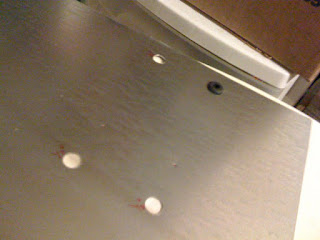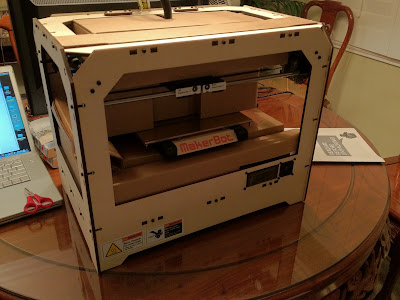After pricing out 4x Intel Quad-Core Q9300 bare bones machines with 4GB ram and 750gb HDD's each (yes, totally overkill for a render node but was cheap at the time), the build came out to be no more than $2500. That's $2500 for 4 individual machines, and 16 render threads.
Including my workstation and the render server which were both Q9300 platforms, I had 24 render threads at my disposal if required.
Roughly, a 6 hour render would then become a 1 hour render.
In retrospect, it would've been easier to just BUY a rack and 4x 2U boxes to house these 4 MicroATX motherboards. But where's the fun in that? I took the opportunity to learn the tools required to build such a box.
PC Parts:
- 4x ASUS P5QPL-AM (cheapest ASUS mATX mobos at the time)
- 4x Intel Q9300 2.5ghz Core2Quad processors
- 4x 4gb Corsair XMS2 ram (2x2gb packs)
- 4x Rosewill (cheapy) CPU fans
- 4x Corsair 400w PSUs
- 4x Western Digital 750gb (or 640gb, not sure anymore)
- D-Link gigabit ethernet / wireless router
- APC UPS
- bulk pack LEDs (2x200 from eBay)
- bulk buttons (100 from eBay)
- Lian-Li HDD anti-vibration mounting kit
- miscellaneous wires, etc.
- 2x2" square wood stock
- miscellaneous bolt and nut (I think it was 3/8")
- washers
- IKEA Hyllis (15$ for 4 planks, as well as the cheap sheet metal frame)
I scoured the web as well as local stores for suitable materials to build platters for each individual blade. What I found was that the IKEA Hyllis galvanized sheet metal shelving system had the perfect dimensions for what I was envisioning for the Quad-Quad.
It was also only $15.00 for all all 4 platters and sheet metal support beams, cheaper than a single sheet of comparable gauge sheet metal from Home Depot. I wasn't planning to weld anything for the mark 1 build of the QuadQuad, so the cheap galvanized sheet metal was perfect.
After finding suitable materials, I began to dimension out all the parts that would be going into the build and made foam core mockup pieces to visualize the spacing.
After dimensioning out the parts and doodling out designs on paper, I decided on going with what looked to be a 2'x2' wooden cube frame structure. It would eventually be covered using 1/4" board panels, and feature dual 200mm fan intakes in front, as well as dual 200mm fan exhausts on the top. Inside would have vertically hanging blades that fit into notches on the support rails.
The frame would be easily disassembled in case the Quad-Quad had to be moved. Instead of glue and nails, I decided to go with a nut and bolt configuration. I'm not sure what this method is called, but I picked it up from browsing DIY CNC machine sites.
For the job of building the frame, I used a Hitachi miter saw I had purchased a few months prior. I believe it was 99$ as an Amazon goldbox deal. It hadn't seen a whole lot of action until I started this project, which is why it looks spick and span in the pictures (as of this writing, it is no longer the case).
I decided to go with wood for the frame because 2"x2" pine were easy to cut and manipulate.
All the wood beams had 1" holes drilled on the side as well as (I believe) 3/8" holes drilled 90 degrees perpendicular to the 1" hole. It's a little hard to explain but you can see in one of the following assembly photos.
Once the frame was built and tested to be structurally sound, I began building out the cover panels from 1/4" thick wood. I don't remember exactly what the type of wood was, but it was also easy to cut.
The Harbor Freight scroll saw came in handy when cutting the 200mm fan holes in the panels.
Utilizing the sheet metal shelves from the IKEA Hyllis purchase, I began cutting to design spec using an angle grinder and a cutoff wheel. It looks weird with the part that bends up from the plate, but I use that to connect each of the 4 platters together for stability and to hold spacing.
The hard drive mounting holes were drilled large enough for the anti-vibration grommets to be seated.
The motherboard offsets were held in place by 6-32 nuts.
After securing the motherboard and hard drive on to the platter, I held it up vertically and shook it gently to make sure the pieces held as anticipated. Since the Quad-Quad Mark 1 wasn't planned to be a mobile platform, no more than a little shake was necessary.
Tested the hanging notches as well.
Once one platter was finished and tested, the same exact thing had to be done 3 more times for the remaining platters.
Over the years I've assembled many PCs so this part was easy peasy. I set up a temporary install station and installed Windows XP SP2 32bit on all the nodes. At that point, Windows XP SP2 32bit worked with all the software I needed to use. The Quad-Quad MK2 later on was upgraded with Windows 7 Pro 64bit on all nodes.
I didn't want to blow the budget by buying power buttons and LEDs from online retailers, so I opted to buy the parts myself in bulk and made my own buttons, power, and HDD activity LEDs.
These buttons were horrible. The contacts inside were unreliable at best. I later on swapped out the power buttons with much nicer ones from Radioshack for the Quad-Quad MK2.
LEDs and power button connected.
All the blade platters mounted on the hanging rails!
If I remember correctly, there were 5cm's between each platter.
The chassis was moved into my room / office and was reassembled. The PSU's as well as the APC battery backup were put into place.
The fan controller is installed on Node #1 of the Quad-Quad, assuming Node #1 will always be on before any of the others are required.
The fan controller is useless if the fans are just dangling, so I put my dad to work. He helped thread the fans so they could be mounted to front and top panels.
However, the top fan was never installed due to miscalculation. There wasn't enough clearance between the top panel and the blade platters for the 200mm fan to fit, so I ended up leaving it. I had plans to finish it and make it look pretty, but just didn't have enough time.
Fast forward toward the end of 2011, and the Quad-Quad MK1 is taken down during room / office renovations. Months later... development for the Quad-Quad MK2 began...






















































